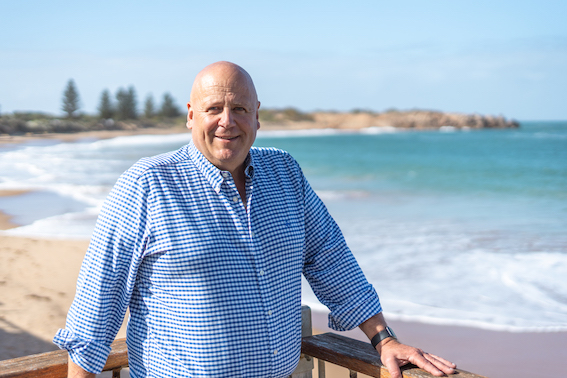Fishing industry left floundering
Julia Beckett
06 July 2025, 8:49 PM
 David Basham with the algal bloom-affected Fleurieu coastline in the background .
David Basham with the algal bloom-affected Fleurieu coastline in the background .Shadow Environment Minister and Finniss MP David Basham wants licence fee relief for fisherman struggling to stay in business while a toxic algal bloom continues to sweep the state’s coastline.
Mr Basham says the state government has failed to adequately acknowledge the challenges faced by regional communities, including fishers and other industry whose livelihoods are reliant on healthy waters.
“It’s disappointing that people in the aquaculture and fishing industries are now being slammed with licence fee increases that many can’t afford to shoulder.
“If the Minister for the Environment, Susan Close thinks those struggling fishing businesses can get insurance coverage for ‘Acts of God’, then I suggest she let them know which insurer to go to because I doubt there is one.
“Meanwhile, the Minister is inferring that fishers should have insured against risks like the algal bloom which was completely unforeseeable.”
Last year, South Australia’s fisheries and aquaculture sectors produced more than 72,000 tonnes of seafood, worth more than $478 million in production value.
Mr Basham says neglecting the impact of the algal bloom could have a costly flow on effect to all consumers who may pay more for seafood, at a time when the cost of living is already a challenge for most people.
“Our aquaculture and fishing sector is a critical industry that must be supported, otherwise all South Australians will pay a high price. This will be especially felt in our regional communities where most of the seafood industry is located as it affects employment in these towns, as well as tourism in the regions.”
The Karenia mikimotoi species of algae, first detected on the Fleurieu Peninsula in March, is now affecting metropolitan beaches.
There have been multiple reports of fish deaths along the metropolitan coastline – North Haven between the river mouth and marina breakwater, Tennyson Beach, north of Grange jetty and south of Christies Beach Surf Life Saving Club – and Port Broughton after the June 24 storm.
The algal bloom has caused discoloured water and foam along parts of the state’s coasts and has affected various marine wildlife, including fish, sharks, rays, and a wide range of invertebrates.
Karenia mikimotoi does not cause long-term harmful effects in humans but exposure to discoloured or foamy water can cause short-term skin or eye irritation and respiratory symptoms, including coughing or shortness of breath.
The state government says the bloom occurs naturally and nothing can be done to dilute or dissipate it.
Experts believe there are three plausible contributing factors causing the bloom:
• A marine heatwave that started in September 2024 – with sea temperatures about 2.5°C warmer than usual – combined with calm conditions, light winds and small swells.
• The 2022-23 River Murray flood washing extra nutrients into the sea.
• An unprecedented cold-water upwelling in summer 2023-24 that has brought nutrient-rich water to the surface.
It had been hoped that cooler weather and winter storms would break up and disperse the algal bloom, but it has spread further, with no indication of when the marine crisis might end.
Acting Premier Susan Close says a cross government working group including SA Health, PIRSA, EPA, SARDI and DEW has been meeting weekly for the last several months to monitor the bloom and to begin preparations for interventions to assist recovery.
"State Government agencies are working together to monitor the algal bloom and provide updates and information to the public, as well as to businesses impacted by the bloom.
"The algal bloom is a dynamic situation. Its movement depends on weather and water conditions, and therefore makes the effect on people and wildlife unpredictable."